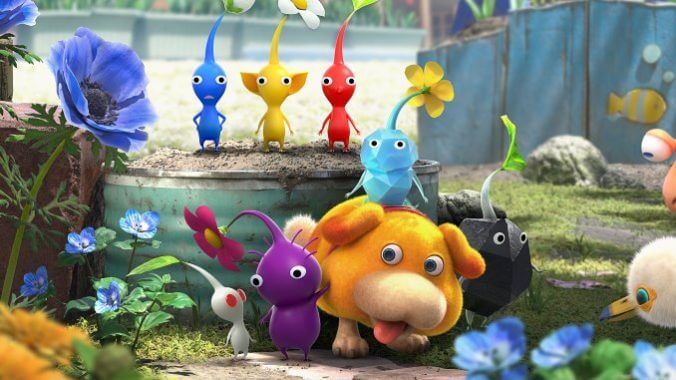I’m a strong proponent of Marie Kondo’s KonMari method. Though I’m not a religious person, Kondo’s spiritual approach to gratitude and the significance of the items we surround ourselves with (and, ultimately, purge) struck a chord with me; the physical space we occupy is at once a mirror of our state of mind and proof of the passage of time, a record of a person’s work and effort over a lifetime.
Pikmin may not be a game about tidying, but it is about careful organization and considerate use of the surrounding world. In its fourth iteration, the franchise finally assigns a word to describe the emergent emotional landscape its gameflow fosters—”dandori.” Dandori doesn’t have a literal translation into English (roughly, it refers to “arrangement” but in the context of a team setting), but is defined in Pikmin 4 as “[organizing] tasks strategically and working effectively to execute plans.” This tenet is the central philosophy behind the Rescue Corps, the group you work for in Pikmin 4, as well as the Leaflings, who cite dandori as a survival strategy for adapting to life on a foreign planet.
The dichotomy crafted here—corporate productivity babble versus self-sufficient survivalism—suggests a sort of collectivist mindset where, to live a truly harmonious life, we must rely on the skills and efforts of the people around us, and trust even the weakest of companions to pull their weight and work like a well-oiled machine. This is, obviously, a slippery mentality to be sold in our modern era. “Hustle culture” has permeated the public consciousness more and more over the last decade, and often, our self-worth is toxically wrapped up in our sense of productivity. Even spiritual practices and meditation have been appropriated by corporate America and organizations like the US military to pacify us out of our negative feelings when suffering under unfit working conditions.
When I was a teenager, I claimed one of my driving forces behind playing videogames was to relax. Really, at the time, there wasn’t a lot I needed to distract myself from—and yet I did feel my most tranquil when gaming. Nowadays, I game less than ever despite the stacking stress I feel in my personal and working lives. Often, videogames feel like a chore. Final Fantasy XVI drew some ire recently for its “MMO”-esque side quests, but this isn’t a problem unique to the game; many these days feel padded with busy work that prey on the dopamine rush felt when completing a slew of simple tasks. Similar to a typical work day, a play session might feel more satisfying or worthwhile if a lot was accomplished in that timeframe. Games have also become longer and longer, with many gamers equating a game’s monetary worth with how many hours of content are packed into it.
Like meditation, when divorced from the baggage that bogs it down, there’s nothing wrong with wanting to feel productive or to improve your efficiency. The knee jerk reaction to the modern work environment is the desire to dismantle labor entirely, but the instinct to work is a natural human drive. Pikmin 4 recontextualizes these concepts into a healthier relationship with not only the work itself, but to our coworkers and the natural world around this.
To watch Pikmin work is truly one of the most beautiful things to witness in a virtual space. They travel down the hypotenuse to and from their onion in a single file line, hum little working songs as they trail being your player character, and jump for joy when they accomplish a hard task. The original Pikmin makes it clear how mutually beneficial your relationship with the Pikmin is—they are a species on the fringes of extinction, and with your help, you propagate their population and teach them to survive with or without your guidance. As much as the Pikmin games are about strategy, they’re also instructional. They’re about recreating patterns and watching as the world functions as intended, and the impact that has not only on your immediate material conditions but on the ecological space surrounding human (or Hocotatian, rather) settlements.
The passion and splendor behind Pikmin 4 is underscored by its horrors. Castaways, including young children, are besieged by nasty carnivorous creatures and forcibly mutated by deranged leaflings. To save them, you must venture out at night when the already horrifying creepy-crawlies of the world go berserk and charge your base. Pikmin 4 would not be as gorgeous of an experience without the brutality faced within; to watch 10 or so Pikmin be impaled, eaten, or flattened in less than a second to absolutely no fanfare is to realize these moments, too, possess a certain serenity. The uncomfortable pain and sadness of Pikmin counterbalances an appreciation for my own toil and the nuance of approaching problems not only creatively and cleverly, but as perfectly as possible.
Austin Jones is a writer with eclectic media interests. You can chat with him about horror games, electronic music, Joanna Newsom and ‘80s-‘90s anime on Twitter @belfryfire
